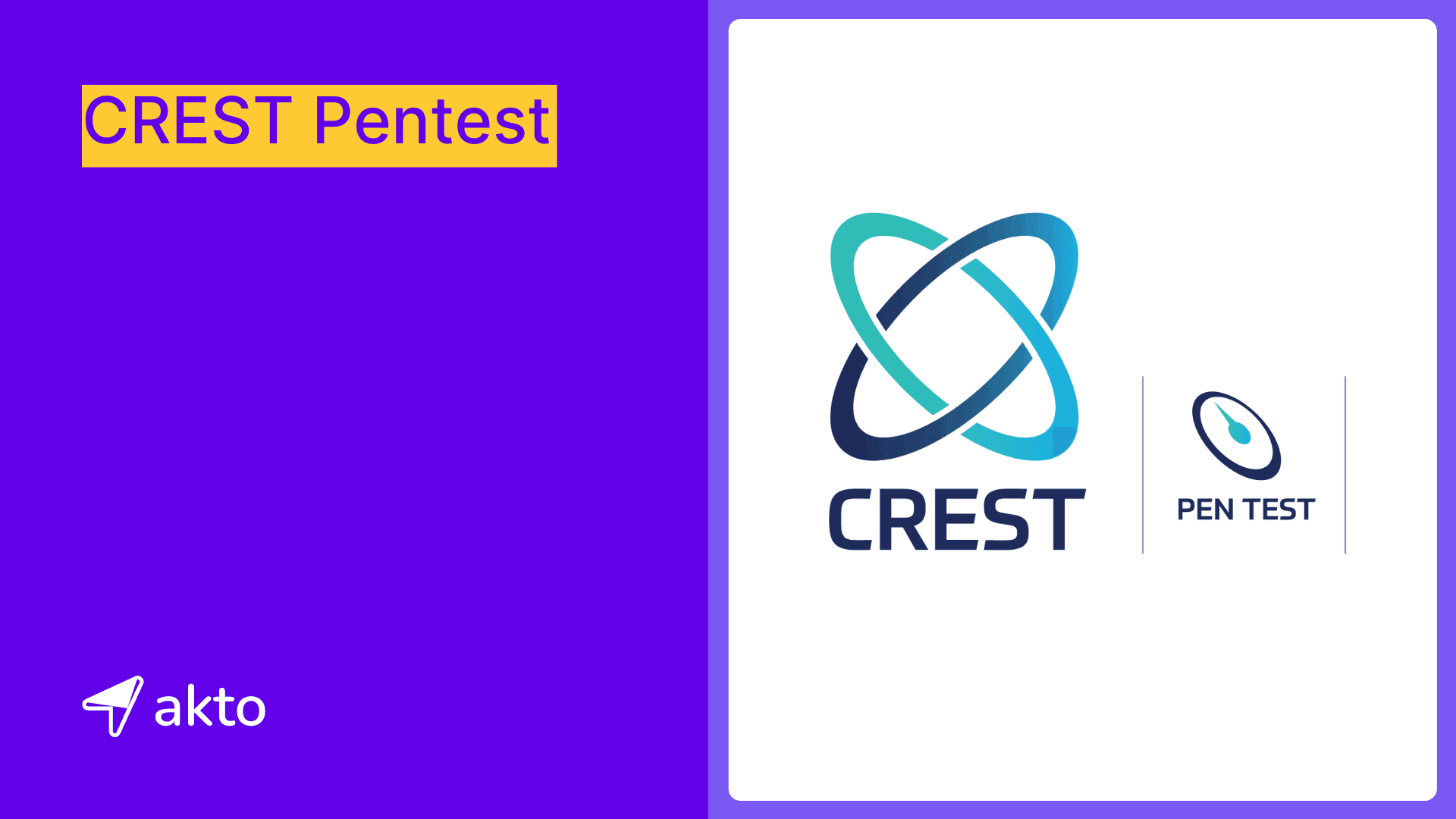CREST Penetration Testing

Insha
Nov 11, 2024
CREST Penetration Testing is a standardized approach to security testing performed by certified professionals from CREST-accredited companies. These tests aim to identify vulnerabilities in an organization's systems, networks, and applications using industry best practices. CREST ensures that the testing is thorough, ethical, and aligned with security standards. This helps organizations strengthen their cybersecurity posture effectively.
This blog provides an in-depth understanding of CREST Accredited Penetration Testing, its importance, and the steps involved in CREST Accredited Penetration Testing.
What is CREST?
CREST stands for the Council of Registered Ethical Security Testers, an esteemed organization, that actively accredits cybersecurity professionals worldwide, offering globally recognized certifications in penetration testing. It rigorously assesses standards of excellence, ensuring professionals possess requisite skills and ethical standards. CREST certifications validate expertise in cybersecurity, enhancing trust among employers and clients while promoting best practices in the industry.
What is CREST Penetration Testing?
CREST Penetration Testing is a standardized process for testing the security of systems, networks, and applications. It adheres to high-quality methodologies and guidelines set by the CREST certification body.
Professionals performing CREST penetration testing assess vulnerabilities, identify security flaws, and provide recommendations to improve an organization’s cybersecurity posture. The testing process includes recon, vulnerability assessment, exploitation, and reporting, ensuring that all security evaluations meet globally recognized rigorous standards.
Need for CREST Accredited Penetration Test?
A CREST Accredited Penetration Test is crucial for ensuring the highest standard of cybersecurity assessment. It assures that the testing follows rigorous methodologies and is conducted by certified professionals who adhere to global best practices.
This level of testing helps organizations accurately identify vulnerabilities, meet regulatory compliance, and safeguard sensitive data. Engaging a CREST-accredited firm ensures thorough, consistent testing quality, which is especially vital for industries with sensitive information and high-security needs, like finance, healthcare, and government sectors.
What Does a CREST-Certified Company Mean?
A CREST-certified company signifies that the company meets the highest standards in cybersecurity, particularly in areas like penetration testing, vulnerability assessments, and threat intelligence. CREST accreditation ensures that the company’s processes, methodologies, and staff adhere to globally recognized best practices and ethical standards.
The certification reflects the company's commitment to quality and professionalism in delivering cybersecurity services. It also assures clients that the company is capable of handling complex security challenges with rigor and expertise, offering a high level of trust and reliability in the cybersecurity industry.
Steps in CREST Accredited Penetration Testing
CREST-accredited penetration testing involves several critical steps designed to systematically evaluate and enhance the security of an organization's assets. Here is a breakdown of the process:
Scoping
In the scoping phase, pentesters and customers work together to define the boundaries and focus areas for the penetration test. This involves deciding which assets (such as web applications, networks, or databases) need auditing, determining the rules of engagement (including which attack vectors are permissible), and understanding the specific security needs of the client.
For example, if a client operates a large e-commerce platform, the scope may prioritize testing for payment security and user data protection. Proper scoping prevents scope creep and helps avoid legal issues by clearly establishing the test's parameters.
Scanning
Once the scope is set, the scanning phase begins, where pen-testers systematically scan and audit the targeted assets. Using both automated tools and manual techniques, they identify potential vulnerabilities, misconfigurations, or non-compliance with security standards.
For instance, pentesters might use tools like Nmap or Burp Suite to detect open ports, outdated software, and weak access controls if scanning a web application. This detailed scanning process ensures that all possible weaknesses are uncovered.
Exploitation
In the exploitation phase, pentesters actively exploit the identified vulnerabilities to understand their potential impact. By attempting real-world attacks like SQL injection, cross-site scripting (XSS), or privilege escalation, they determine how a vulnerability could be used by a malicious actor.
The severity of vulnerabilities is assessed using the Common Vulnerability Scoring System (CVSS), which rates risks on a scale of 1 to 10. For example, a vulnerability that allows unauthorized access to sensitive data may receive a CVSS score between 8 and 10, indicating a critical threat that needs immediate remediation.
Reporting
After testing, a comprehensive report is created for the client, detailing the vulnerabilities found, the exploitation methods used, and the remediation recommendations. This report not only identifies the security gaps but also serves as a guide for prioritizing fixes.
For instance, a company that handles personal data may receive recommendations to update encryption standards and restrict access controls based on the test findings. The report also helps with compliance documentation for regulatory requirements.
Remediation
The remediation phase involves implementing the fixes and recommendations provided in the report. Vulnerabilities are prioritized based on their criticality, with high-risk issues addressed first to ensure that serious security flaws are promptly resolved.
For example, a vulnerability that allows an attacker to gain administrator privileges would be remediated before less severe issues like minor misconfigurations. The organization works to patch these vulnerabilities, update security controls, and strengthen policies.
Rescanning
After remediation, a rescan is conducted to verify that the vulnerabilities have been properly addressed and that no new issues have arisen. Pentesters use similar tools and methodologies as in the initial scanning phase to confirm that the security patches are effective.
For instance, after fixing a cross-site scripting (XSS) vulnerability, the security team would attempt to exploit it again to ensure the flaw is no longer present. This post-patching validation assures that the system is now more secure and reduces the likelihood of future security breaches.
Why Choose a CREST-Accredited Company?
Choosing a CREST-accredited company ensures high-quality, professional cybersecurity services. These companies undergo rigorous assessments to demonstrate their expertise and commitment to best practices.
Government entities, public services, and businesses trust CREST-accredited firms to thoroughly test and secure their systems. Their personnel are highly qualified, staying current with the latest threats and methodologies.
Adherence to enforceable Codes of Conduct and Ethics guarantees integrity and accountability. Any issues are addressed promptly through CREST’s resolution measures. This approach ensures organizations receive top-tier security aligned with industry standards.
Final Thoughts
Choosing a CREST-accredited company for penetration testing provides a host of benefits. Not only does it offer assurance of the skill and competence of the professionals involved, but it also demonstrates a commitment to maintaining security best practices.
This can provide a competitive edge and supports regulatory compliance. With the global recognition of CREST accreditation, it can also offer assurances to international operations or organizations dealing with overseas clients.
Explore more from Akto
Blog
Be updated about everything related to API Security, new API vulnerabilities, industry news and product updates.
Events
Browse and register for upcoming sessions or catch up on what you missed with exclusive recordings
CVE Database
Find out everything about latest API CVE in popular products
Test Library
Discover and find tests from Akto's 100+ API Security test library. Choose your template or add a new template to start your API Security testing.
Documentation
Check out Akto's product documentation for all information related to features and how to use them.

